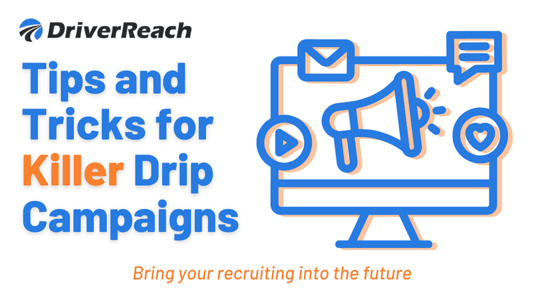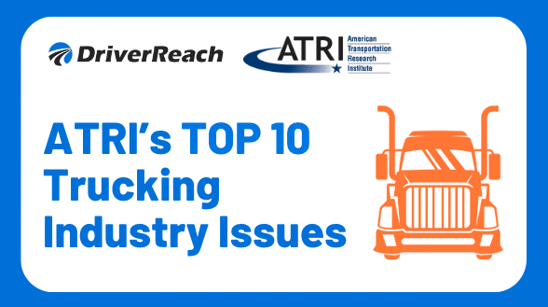Did you have a chance to attend webinar, “Part 1: Driver Retention 101 With WorkHound: Why Your Drivers Aren't Sticking Around”? We received more questions than we had time to answer in the allotted time frame, so our presenter from WorkHound, Max Farrell, has answered them below in this Q&A-style blog post. If you weren’t able to join the live webinar, don’t worry – you can watch it on-demand anytime!
Question: Do you believe driver retention could be increased for companies if they were to upgrade sleeper accessories... mattresses, pillows, bed sheets. Etc.?
Answer: Potentially. Retention is a concern across all fleets, even for drivers without sleeper units. While upgrading sleeper accessories could help, it’s more important to take a step back and ask the drivers for the solution to keep them. As they say, “To assume is to make an ass out of you and me.” We don’t recommend operating on assumptions.
Communication is the key and an improvement in communication will have the widest, most impactful response in terms of retention. Specifically: Listen. Your drivers are living on the frontline, day-in and day-out. Be open to their responses. If you ask them what could help keep them, and they say “Better sleeper accessories.” Then listen, act, and respond by letting every driver know that their feedback is truly valuable, it’s being heard, and it’s making an impact for the livelihood of fellow drivers.
Question: Aside from the pet policy change at Marten Transport, what other major changes have you seen from carriers using feedback as a retention strategy?
Answer: On a macro level, several carriers have made major changes based on feedback. From pay structure and rate to hiring additional support staff and changing routes to even allowing for more home time, companies are taking feedback seriously because drivers are their most valuable assets.
On a more interpersonal level, WorkHound offers a tool to ask the driver to reveal their identity so that the carrier can intervene in the concerns they’ve brought forward in feedback and course-correct to earn driver trust. The dashboard actually starts a timer when that interaction begins to prove the value of each company’s efforts in these trust-earning conversations. But it’s not all about reviewing concerns and pitfalls.
We’ve also received tons of positive feedback for companies and that typically presents the greatest surprise in driver comments. Positive feedback helps WorkHound customers understand what’s going right, what should be replicated, and what praise drivers present for members of support staff. This also proves to be great content for recruiting. As they say, “The best recruiter is a happy driver.”
Question: How does the culture within the fleet and having a new driver understand and fit within that culture increase driver retention?
Answer: Culture is everything for new drivers. There are too many carriers working hard to intentionally shape culture that if your carrier isn’t being conscientious about what that means for you and your drivers, you’re missing out.
For starters, for a new driver: how clearly have expectations been communicated for both the driver and the company? If you sell the driver on an experience that doesn’t exist in your company, then trust is already broken and the culture isn’t one that sets everyone up for success.
Similarly, if you say your company has a “family culture,” but you’re not willing to make sure drivers can get home to spend time with their actual family or they’re unable to occasionally bring along a guest, then the idea of family is lost on their experience and inevitably, your drivers are going to move on to a place where they can accomplish those ideals.
Drivers are giving a lot of their time and livelihood to you, now it’s more important than ever to ask them what kind of culture they’re looking for and act on their vision.
Question: What is the average cost to replace a driver?
Answer: The average cost to replace a driver has been determined industry-wide to be $8200. https://www.thetruckersreport.com/shortage/ Because this is an average, we know that some carriers have been able to fine-tune this process to be as low as $2000, while other more specialized carriers have to spend up to $20,000 to replace a driver.
This factors in entry and exit administration, fixed asset costs, profit loss, productivity loss and recruiting replacement efforts. We hypothesize that if the shortage increases as projected, so will this cost.
Question: Are anonymous feedback forms preferred method of communication for drivers ?
Answer: Communication is key. Unfortunately, there’s a long history of drivers perceiving that trucking companies are taking advantage of them and that means there’s trust to earn. You might be doing a great job with transparent communication, and yet, drivers are operating with baggage from old experiences. While some drivers do feel comfortable relying on an open-door policy, the silent majority prefer a safety net like anonymous feedback so that they can truly share what’s on their mind without the fear of repercussion.
For many carriers that begin working with WorkHound, the first couple of months are strictly anonymous with drivers and once the company begins to answer driver feedback with change, confidence grows and drivers feel more comfortable revealing their identity to have better, trust-earning one-on-one conversations.
Stay up to date on CDL trucking trends! Be sure to check out the DriverReach blog or follow us on LinkedIn for other relevant articles and head over to our webinars page for an up-to-date list of upcoming events and on-demand recordings.
Interested in seeing DriverReach’s modern Recruiting Management System in action? Request a demo!



